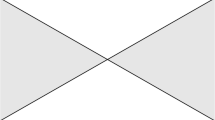Abstract
Let \(\textrm{R}\) be a real closed field and \(\textrm{C}\) the algebraic closure of \(\textrm{R}\). We give an algorithm for computing a semi-algebraic basis for the first homology group, \(\textrm{H}_1(S,{\mathbb {F}})\), with coefficients in a field \({\mathbb {F}}\), of any given semi-algebraic set \(S \subset \textrm{R}^k\) defined by a closed formula. The complexity of the algorithm is bounded singly exponentially. More precisely, if the given quantifier-free formula involves s polynomials whose degrees are bounded by d, the complexity of the algorithm is bounded by \((s d)^{k^{O(1)}}\). This algorithm generalizes well known algorithms having singly exponential complexity for computing a semi-algebraic basis of the zeroth homology group of semi-algebraic sets, which is equivalent to the problem of computing a set of points meeting every semi-algebraically connected component of the given semi-algebraic set at a unique point. It is not known how to compute such a basis for the higher homology groups with singly exponential complexity. As an intermediate step in our algorithm we construct a semi-algebraic subset \(\Gamma \) of the given semi-algebraic set S, such that \(\textrm{H}_q(S,\Gamma ) = 0\) for \(q=0,1\). We relate this construction to a basic theorem in complex algebraic geometry stating that for any affine variety X of dimension n, there exists Zariski closed subsets
with \(\dim _\textrm{C}Z^{(i)} \le i\), and \(\textrm{H}_q(X,Z^{(i)}) = 0\) for \(0 \le q \le i\). We conjecture a quantitative version of this result in the semi-algebraic category, with X and \(Z^{(i)}\) replaced by closed semi-algebraic sets. We make initial progress on this conjecture by proving the existence of \(Z^{(0)}\) and \(Z^{(1)}\) with complexity bounded singly exponentially (previously, such an algorithm was known only for constructing \(Z^{(0)}\)).












Similar content being viewed by others
Notes
In case \(\textrm{D}= {\mathbb {Z}}\), it is possible to deduce the bit-complexity of our algorithms in terms of the bit-sizes of the coefficients of the input polynomials, and this will agree with the classical (Turing) notion of complexity. We do not state the bit complexity separately in our algorithms, but note that it is always bounded by a polynomial in the bit-size of the input times the complexity upper bound stated in the paper. We do not count the cost of doing linear algebra over the field \({\mathbb {F}}\). However, if \({\mathbb {F}}= {\mathbb {Q}}\), then the bit complexity of doing operations over \({\mathbb {F}}\) will be bounded by the complexity upper bound stated in the paper.
The reason behind insisting on “semi-algebraically” connected instead of just connected (in the Euclidean topology) is that over an arbitrary real closed field these two notions are distinct. On the other hand if \(\textrm{R}= {\mathbb {R}}\), then being semi-algebraically connected is equivalent to being connected (see for example [7, Thm. 5.22]).
It is a consequence of the well-known Thom’s lemma, that the Thom encoding uniquely characterizes a root in \(\textrm{R}\) of a polynomial in \(\textrm{D}[X]\) (see for example, [7, Prop. 2.27]).
Not to be confused with the homological functor \(\textrm{Ext}(\cdot ,\cdot )\).
Note that without the requirement that the output formula be closed it is straight-forward to obtain a singly exponential complexity algorithm via quantifier elimination.
References
Basu, S.: On bounding the Betti numbers and computing the Euler characteristic of semi-algebraic sets. Discrete Comput. Geom. 22(1), 1–18 (1999)
Basu, S.: Computing the first few Betti numbers of semi-algebraic sets in single exponential time. J. Symb. Comput. 41(10), 1125–1154 (2006)
Basu, S.: Algorithms in Real Algebraic Geometry: A Survey. Real Algebraic Geometry. Panorama et Synthèses, vol. 51, pp. 107–153. Société mathématique de France, Paris (2017)
Basu, S., Pollack, R., Roy, M.-F.: On computing a set of points meeting every cell defined by a family of polynomials on a variety. J. Complex. 13(1), 28–37 (1997)
Basu, S., Pollack, R., Roy, M.-F.: Computing roadmaps of semi-algebraic sets on a variety. J. Am. Math. Soc. 13(1), 55–82 (2000)
Basu, S., Pollack, R., Roy, M.-F.: Computing the Euler–Poincaré characteristics of sign conditions. Comput. Complex. 14(1), 53–71 (2005)
Basu, S., Pollack, R., Roy, M.-F.: Algorithms in Real Algebraic Geometry. Algorithms and Computation in Mathematics, vol. 10, 2nd edn. Springer, Berlin (2006)
Basu, S., Roy, M.-F., Safey El Din, M., Schost, É.: A baby step-giant step roadmap algorithm for general algebraic sets. Found. Comput. Math. 14(6), 1117–1172 (2014)
Basu, S., Karisani, N.: Efficient simplicial replacement of semialgebraic sets. Forum Math. Sigma 11, e41 (2023)
Basu, S., Karisani, N.: Persistent homology of semi-algebraic sets. SIAM J. Appl. Algebra Geom. (2023). https://doi.org/10.1137/22M1494415
Basu, S., Pollack, R., Roy, M.-F.: Computing the first Betti number of a semi-algebraic set. Found. Comput. Math. 8(1), 97–136 (2008)
Basu, S., Roy, M.-F.: Divide and conquer roadmap for algebraic sets. Discrete Comput. Geom. 52(2), 278–343 (2014)
Blum, L., Cucker, F., Shub, M., Smale, S.: Complexity and Real Computation. Springer, New York (1998) (With a foreword by Karp, R.M.)
Bürgisser, P., Cucker, F., Lairez, P.: Computing the homology of basic semialgebraic sets in weak exponential time. J. ACM 66(1), Art. 5, 30 (2019) [Publication date initially given as 2018]
Bürgisser, P., Cucker, F., Tonelli-Cueto, J.: Computing the homology of semialgebraic sets. I: Lax formulas. Found. Comput. Math. 20(1), 71–118 (2020)
Bürgisser, P., Cucker, F., Tonelli-Cueto, J.: Computing the homology of semialgebraic sets. II: general formulas. Found. Comput. Math. 21(5), 1279–1316 (2021)
Canny, J.: Computing roadmaps of general semi-algebraic sets. Comput. J. 36(5), 504–514 (1993)
Cartan, H., Eilenberg, S.: Homological Algebra. Princeton Landmarks in Mathematics. Princeton University Press, Princeton (1999) (With an appendix by Buchsbaum, D.A., Reprint of the (1956) original)
Dey, T.K., Hou, T., Mandal, S.: Computing minimal persistent cycles: polynomial and hard cases. In: Proceedings of the 2020 ACM-SIAM Symposium on Discrete Algorithms, pp. 2587–2606. SIAM, Philadelphia (2020)
Erickson, J., Whittlesey, K.: Greedy optimal homotopy and homology generators. In: Proceedings of the 16th Annual ACM-SIAM Symposium on Discrete Algorithms, pp. 1038–1046. ACM, New York (2005)
Gournay, L., Risler, J.-J.: Construction of roadmaps in semi-algebraic sets. Appl. Algebra Eng. Commun. Comput. 4(4), 239–252 (1993)
Grigor’ev, D.Y., Vorobjov, N.N., Jr.: Counting connected components of a semialgebraic set in subexponential time. Comput. Complex. 2(2), 133–186 (1992)
Grigoriev, D.Y., Vorobjov, N.N., Jr.: Solving systems of polynomial inequalities in subexponential time. J. Symb. Comput. 5(1–2), 37–64 (1988)
Heintz, J., Roy, M.-F., Solernó, P.: Single exponential path finding in semi-algebraic sets. II. The general case. In: Algebraic Geometry and Its Applications (West Lafayette, IN, 1990), pp. 449–465. Springer, New York (1990)
Milnor, J.: On the Betti numbers of real varieties. Proc. Am. Math. Soc. 15, 275–280 (1964)
Nori, M.V.: Constructible Sheaves, Algebra, Arithmetic and Geometry, Part I, II (Mumbai, 2000). Tata Institute of Fundamental Research Studies in Mathematics, vol. 16, pp. 471–491. Tata Institute of Fundamental Research Studies, Bombay (2002)
Obayashi, I.: Volume-optimal cycle: tightest representative cycle of a generator in persistent homology. SIAM J. Appl. Algebra Geom. 2(4), 508–534 (2018)
Petrovskiĭ, I.G., Oleĭnik, O.A.: On the topology of real algebraic surfaces. Izvestiya Akad. Nauk SSSR. Ser. Mat. 13, 389–402 (1949)
Rotman, J.J.: An Introduction to Algebraic Topology. Springer, New York (1988)
Schwartz, J.T., Sharir, M.: On the “piano movers’’ problem. II. General techniques for computing topological properties of real algebraic manifolds. Adv. Appl. Math. 4(3), 298–351 (1983)
Thom, R.: Sur l’homologie des variétés algébriques réelles. In: Differential and Combinatorial Topology (A Symposium in Honor of Marston Morse), pp. 255–265. Princeton University Press, Princeton (1965)
Acknowledgements
We are grateful to the anonymous referees for their comments which helped to improve the paper. This research was supported by the National Science Foundation grant CCF-1910441.
Author information
Authors and Affiliations
Corresponding author
Ethics declarations
Conflict of interest
On behalf of all authors, the corresponding author states that there is no conflict of interest. Data sharing not applicable to this article as no datasets were generated or analysed during the current study.
Additional information
Editor in Charge: Kenneth Clarkson
Dedicated to the memory of Eli Goodman.
Publisher's Note
Springer Nature remains neutral with regard to jurisdictional claims in published maps and institutional affiliations.
S. Basu was partially supported by NSF grants CCF-1618918, DMS-1620271 and CCF-1910441.
Rights and permissions
Springer Nature or its licensor (e.g. a society or other partner) holds exclusive rights to this article under a publishing agreement with the author(s) or other rightsholder(s); author self-archiving of the accepted manuscript version of this article is solely governed by the terms of such publishing agreement and applicable law.
About this article
Cite this article
Basu, S., Percival, S. Efficient Computation of a Semi-Algebraic Basis of the First Homology Group of a Semi-Algebraic Set. Discrete Comput Geom (2024). https://doi.org/10.1007/s00454-024-00626-0
Received:
Revised:
Accepted:
Published:
DOI: https://doi.org/10.1007/s00454-024-00626-0




